
GORIZIA
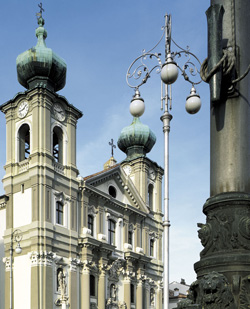 Goldoni was enchanted by this town and had such a pleasant stay. (He wrote
«Non v’è provincia in Italia ove vi sia tanta nobiltà
come in questa» (There is no other town except for Gorizia that has
such a noble character). However, he was not the only one to have written
about this town. Giacomo Casanova, for instance, who stayed in Gorizia in
1773, wrote «Mi trattenni a Gorizia per sei settimane e vi trovai tutti
gli svaghi che potevo desiderare» (I spent six weeks in Gorizia and
I found all possible entertainment). Such witnesses, although ancient, are
still able to describe the discreet and aristocratic beauty of this town,
which is characterized by a secret melancholy, typical of the Middle European
towns.
Goldoni was enchanted by this town and had such a pleasant stay. (He wrote
«Non v’è provincia in Italia ove vi sia tanta nobiltà
come in questa» (There is no other town except for Gorizia that has
such a noble character). However, he was not the only one to have written
about this town. Giacomo Casanova, for instance, who stayed in Gorizia in
1773, wrote «Mi trattenni a Gorizia per sei settimane e vi trovai tutti
gli svaghi che potevo desiderare» (I spent six weeks in Gorizia and
I found all possible entertainment). Such witnesses, although ancient, are
still able to describe the discreet and aristocratic beauty of this town,
which is characterized by a secret melancholy, typical of the Middle European
towns. Gorizia is one of the most atypical towns of Italy hanging between the German and the Venetian world . From a cultural point of view, it represents the crossroads of three different civilizations that have characterized the Latin, Slavic and Germanic Europe. It is known for having been host to one of the flash-points of the First World War. This apocalyptic and tragic event has overshadowed the original and prestigious roots of the town that has a remarkable heritage and has become known at the closing of the first millennium of history, celebrated in 2001.
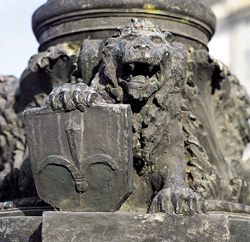 The Castle stands out imposingly in an enchanting borough and represents the
most ancient origins of the town. During the Middle Ages it was the residence
of the powerful Counts of Gorizia, whose properties covered huge territories
in Northern Italy, Slovenia, Bohemia and Croatia.
The Castle stands out imposingly in an enchanting borough and represents the
most ancient origins of the town. During the Middle Ages it was the residence
of the powerful Counts of Gorizia, whose properties covered huge territories
in Northern Italy, Slovenia, Bohemia and Croatia. A visit to the town starts with a tour of this castle that is known for its austere and fascinating style. It is one of the most beautiful castles of the region, which was designed for a Prince of the German Empire (the Counts of Gorizia belonged to the same high rank). The ground floor has a simple dining room with a kitchen typical of Friuli and a Hall featuring the knights’ armoury that has been restored also on its cultural history. The Hall contains swords, lances, maces, helmets and shields that were used in Gorizia from the 11th to the 15th century.
The first floor hosts the halls destined to official events such as the elegant Sala del Conte (which today is used as a meeting and conference room), the beautiful room dedicated to medieval music instruments and the huge hall of the Stati Provinciali (local government bodies), which frequently hosts international exhibitions. The second floor hosts the chapel and the huge panoramic Sala del Granaio (hall of the granary) featuring the first collection of the medieval museum that will be built soon. Through plastic models, artefacts and interactive exhibits, the tour allows visitors to learn about the history of Gorizia from 1001 to the 1500s in a simple and direct way. During that period, Leonardo, the last Count of the descent, married to Paola Gonzaga, died without children. Leonardo passed on his legacy and property to Massimiliano d’Asburgo, who, thanks to this heritage, built his fortune on a dynasty that he ruled up to 1918. The huge war machines such as battering rams, catapults/launchers placed around the castle remind of its remarkable defensive role at that time.
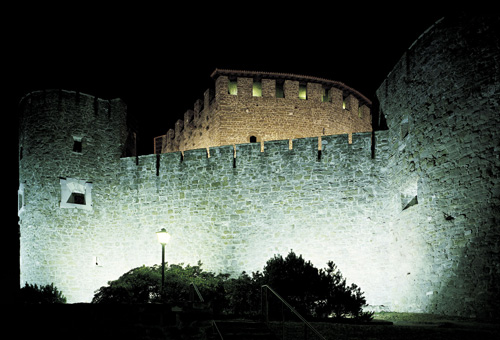 Not far from the castle, adjacent to the borough, lie many remarkable buildings
such as the 14th-century church of Santo Spirito, the Museo della Grande Guerra
(museum of the great war), (not to be missed especially by those who wish
to better understand one of the milestones of our history), the Museo della
moda e delle arti applicate (museum of fashion and applied arts), the archaeological
museum and the ethnographic museum, whose collections formerly belonged to
the provincial museums.
Not far from the castle, adjacent to the borough, lie many remarkable buildings
such as the 14th-century church of Santo Spirito, the Museo della Grande Guerra
(museum of the great war), (not to be missed especially by those who wish
to better understand one of the milestones of our history), the Museo della
moda e delle arti applicate (museum of fashion and applied arts), the archaeological
museum and the ethnographic museum, whose collections formerly belonged to
the provincial museums. As we walk down the Riva Castello, we reach the heart of the historic centre of Gorizia. The bell tower of the Cathedral stands out on the elegant and secluded piazza Cavour. The nearby piazza Sant’Antonio is surrounded by a wide portico and the 16th-century Baroni Lantieri building. Going past the ancient via Castello and its typical shops, we reach piazza Vittoria, which is characterized by the onion-like domes of typical Austrian style and by the 18th century church of Sant’Ignazio. Not far away there is the most remarkable building of Gorizia: the spectacular Attems-Santacroce building on piazza De Amicis which is now the seat of the Musei Provinciali (local museums). The building was designed by Nicolò Pacassi from Gorizia, one of the most important architects of the 18th century Hapsburg dominion, and one of Empress Maria Teresa’s favourites; among his best works is the Schönbrunn Residence in Vienna as well as villas and palaces scattered across the territories of the former Hapsburg Empire.
Directly behind palazzo Attems, in via Ascoli stands the ancient Ghetto with the Synagogue, which has recently been restored to host the museum of the Jewish culture; a tribute to the Jewish community of the town, nearly totally disappeared today. This Ghetto has played a fundamental role for the culture of Gorizia and Italy (to name but a few, are Carlo Michelstaedter, one of the most noteworthy philosophers of Middle Europe, who lived at the beginning of the 20th century, Graziadio Isaia Ascoli, one of the most important European linguists and Carolina Luzzatto, the first Italian woman to become editor of a newspaper).
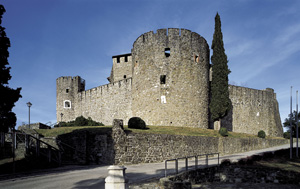 At this point, we are offered two alternative routes: strolling along Corso
Verdi and Corso Italia, with their elegant shops and open air bars or going
across the shadowy and picturesque viale XX Settembre, which hosts another
remarkable treasure of Gorizia: Villa Coronini Cronberg. Surrounded by a huge
park covering 46 thousand square metres, the villa (which features an enormous
artistic and photographic heritage) has been donated to the town by its last
owner, Count Guglielmo.
At this point, we are offered two alternative routes: strolling along Corso
Verdi and Corso Italia, with their elegant shops and open air bars or going
across the shadowy and picturesque viale XX Settembre, which hosts another
remarkable treasure of Gorizia: Villa Coronini Cronberg. Surrounded by a huge
park covering 46 thousand square metres, the villa (which features an enormous
artistic and photographic heritage) has been donated to the town by its last
owner, Count Guglielmo. The villa is open to the public and hosts small exhibitions regularly throughout the year. As we walk along viale XX Settembre we reach the ponte del Torrione (bridge of the tower), which offers one of the most remarkable views on the Isonzo river. If we continue on the so-called “wine and cherry Route”, we reach the heart of the Gorizia Collio, the area of the best Italian white wines and as many (although less well known) red wines.
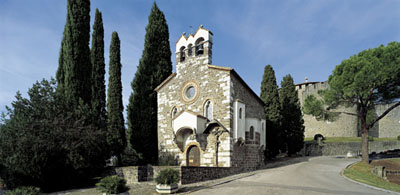 Gorizia boasts original characteristics also in cuisine: Italian, from Friuli,
Austrian, Slovenian as well as Hungarian and German recipes have been passed
on from mother to daughter. At times they have been modified, altered with
other influences, or maintained unchanged. They represent a really unique
gastronomic offer thanks to their unusual flavours and combinations, which
can be found in the typical trattorie as well as in the elegant restaurants
in town. A truly remarkable cuisine accompanied by excellent local wines,
such as the DOC (Denomination of Controlled Origin) from the Collio and the
Isonzo areas: the white and aromatic Tocai, Malvasia istriana, Ribolla, Sauvignon,
Pinot wines white and grey varieties, the precious Picolit (a wine for “meditation”),
the full-bodied Cabernet, Merlot, Pinot, and Refosco red wines. A typical
dish from Gorizia is the ham baked in bread, flavoured with some grated spicy
cren (horseradish) and served as a single dish at lunch: it is also a typical
meal served in the past as today at Easter time. Other typical entrees are
soups and gnocchi. A very tasty soup is the jota (mixed stewed vegetables
such as sour cabbage, potatoes, beans and pork rinds) and the soup from Friuli
made of barley and beans. Some typical main courses show Middle European influences:
muset e brovade (pork sausage with white grated turnips, brewed in the marc),
gulasch (spicy meats of clear Hungarian origins), kaiserfleisch (the meat
of the Emperor), steaks of smoked pork flavoured with fresh grated horseradish
and served with sauerkraut or gnocchi made of bread: a dish of clear Vienna
origins. The Adriatic Sea, which is only 40 km away, has also influenced the
Gorizia cuisine. Fish has an important role in the menu and is offered especially
on Fridays. Lastly desserts: the most typical cake is the gubana di Gorizia,
a delicious roll of puff pastry full of dried fruits such as raisins, candied
fruits, pine seeds and walnuts, which is sold in every pasticceria and bakery
of the town.
Gorizia boasts original characteristics also in cuisine: Italian, from Friuli,
Austrian, Slovenian as well as Hungarian and German recipes have been passed
on from mother to daughter. At times they have been modified, altered with
other influences, or maintained unchanged. They represent a really unique
gastronomic offer thanks to their unusual flavours and combinations, which
can be found in the typical trattorie as well as in the elegant restaurants
in town. A truly remarkable cuisine accompanied by excellent local wines,
such as the DOC (Denomination of Controlled Origin) from the Collio and the
Isonzo areas: the white and aromatic Tocai, Malvasia istriana, Ribolla, Sauvignon,
Pinot wines white and grey varieties, the precious Picolit (a wine for “meditation”),
the full-bodied Cabernet, Merlot, Pinot, and Refosco red wines. A typical
dish from Gorizia is the ham baked in bread, flavoured with some grated spicy
cren (horseradish) and served as a single dish at lunch: it is also a typical
meal served in the past as today at Easter time. Other typical entrees are
soups and gnocchi. A very tasty soup is the jota (mixed stewed vegetables
such as sour cabbage, potatoes, beans and pork rinds) and the soup from Friuli
made of barley and beans. Some typical main courses show Middle European influences:
muset e brovade (pork sausage with white grated turnips, brewed in the marc),
gulasch (spicy meats of clear Hungarian origins), kaiserfleisch (the meat
of the Emperor), steaks of smoked pork flavoured with fresh grated horseradish
and served with sauerkraut or gnocchi made of bread: a dish of clear Vienna
origins. The Adriatic Sea, which is only 40 km away, has also influenced the
Gorizia cuisine. Fish has an important role in the menu and is offered especially
on Fridays. Lastly desserts: the most typical cake is the gubana di Gorizia,
a delicious roll of puff pastry full of dried fruits such as raisins, candied
fruits, pine seeds and walnuts, which is sold in every pasticceria and bakery
of the town. 